Muktinath Temple is a famous pilgrimage destination and tourist attraction situated in the Mustang district of Nepal. Along the majestic backdrop of the Annapurna and Dhaulagiri ranges, this sacred site stands at about 3,710 meters elevation from sea level – making it one of the world’s highest temples. Muktinath has been an important site for centuries, drawing visitors seeking spiritual solace and adventure amid stunning Himalayan scenery.
How to Reach Muktinath Temple from Kathmandu or Pokhara
Travel to Muktinath Temple requires a bit of planning due to its remote Himalayan location, but the journey is an adventure in itself. Most travelers start from either Kathmandu or Pokhara, the two major cities in Nepal, and then head towards the Mustang region where Muktinath is located.
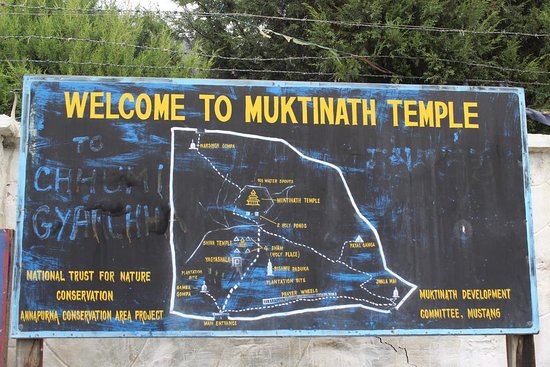
From Kathmandu to Muktinath temple
By road: The distance by road from Kathmandu to Muktinath is roughly 370–380 km, which can take 15 hours or more of driving across mountainous terrain. The typical overland route is to drive from Kathmandu to Pokhara (approximately 6–7 hours on the Prithvi Highway), stay overnight, and then continue from Pokhara to Jomsom and Muktinath.
By air: Nowadays, a popular option is to break up the journey by air travel. You can take a short 25-minute flight from Kathmandu to Pokhara, then connect to a smaller aircraft for a spectacular 15-minute flight up the Kali Gandaki valley to Jomsom. Jomsom has a small airport (2,700 m altitude) that serves as the gateway to the Mustang region. From Jomsom, Muktinath is about 23 km away – travelers cover this last leg by hiring a local jeep or bus, which takes around 1.5 to 2 hours on a rough road up to the temple area. For those who prefer trekking, it’s also possible to trek from Jomsom to Muktinath over two days, enjoying the scenery along the Annapurna Circuit trail.
By trek: There is another path for the adventure seekers, the path leading from the east (Manang side) can even reach Muktinath by crossing the Thorong La Pass (5,416 m) on foot as part of a longer trek – though this is a challenging route suitable for experienced trekkers.
Links: https://mustangnepal.com/kathmandu-to-lower-mustang/
Pokhara to Muktinath temple<
By road : Pokhara is the nearest big city and a common launching point for Muktinath trips. By road, the distance from Pokhara to Muktinath (via Beni and Jomsom) is about 175 km. Don’t be fooled by the distance – due to rugged mountain roads, this drive takes around 8 to 9 hours by four-wheel-drive Jeep. Daily public jeeps or buses depart Pokhara early morning and usually reach the town of Jomsom by late afternoon; from Jomsom, you continue onward by jeep up to Muktinath. Road conditions can be rough, especially after monsoon rains, so hiring an experienced driver or joining a jeep tour is recommended.
By air: As mentioned, you can fly from Pokhara to Jomsom in about 15-20 minutes if the weather is favorable. These flights are usually early morning only, due to strong winds in the Mustang valley later in the day. Once in Jomsom, a jeep ride or a moderate hike will get you to the temple. There is no direct commercial flight all the way to Muktinath, but chartered helicopter services are available for those who wish to skip ground travel. A helicopter from Pokhara or even Kathmandu can take you directly near Muktinath in about 45 minutes to an hour. This is the fastest and most expensive) way, often used by pilgrims on tight schedules.
Travel permits for the Mustang region:
If you are trekking or traveling independently in the Muktinath area which lies inside the Annapurna Conservation Area, you will need to obtain the ACAP (Annapurna Conservation Area Permit) and a TIMS (Trekkers’ Information Management System) card. These can be arranged in Kathmandu or Pokhara through the Tourism Board office or via trekking agencies. Organized tour groups usually handle permits for you. Always check the latest road and weather conditions before you set out – landslides or flight cancellations can occur, especially during the monsoon season. With a bit of preparation, the journey to Muktinath is safe and rewarding, offering incredible views of the Himalayas at every turn and a glimpse into life in Nepal’s high mountain villages.
History and Significance of Muktinath Temple
Muktinath Temple has a rich history intertwined with spiritual lore and cultural exchange. The very name “Muktinath” means “Lord of Liberation,” reflecting the belief that this place grants moksha (salvation) to devotees. For over a thousand years, pilgrims have journeyed to this remote valley, which lay along the ancient salt trade route between India and Tibet. This trading path brought together people of diverse backgrounds, helping make Muktinath a symbol of Hindu-Buddhist harmony in Nepal. The current pagoda-style temple was formally built in the early 19th century under the patronage of Queen Subarna Prabha of Nepal, who initiated construction around 1815.

Despite its small size, the temple’s significance is immense. It is dedicated to Lord Vishnu (worshiped here as Mukti Narayana) and is revered as one of the 108 Divya Desam – holy shrines of Vishnu venerated by Sri Vaishnavites. In fact, Muktinath is the only Divya Desam located outside of India, which underscores its importance in the Hindu spiritual geography. The complex is often called Mukti Kshetra (“Place of Liberation”) and is counted among the Char Dham (four sacred abodes) of Nepal.
Adding to its mystique, the site incorporates an eternal flame fed by natural gas and 108 sacred water spouts (Mukti Dhara) where pilgrims bathe to purify themselves. These unique features – earth, fire, and water elements – contribute to the temple’s aura as a place where natural elements meet the divine. Over the centuries, saints and yogis (from Hindus to Buddhist monks) meditated here, further sanctifying the area. In every corner of Muktinath, the convergence of history, nature, and faith creates a profound sense of peace and sanctity for visitors.
Importance of Muktinath Temple for Hindus and Buddhists
Muktinath’s spiritual importance spans both Hindu and Buddhist traditions, making it a unique shrine of interfaith reverence. For Hindus, Muktinath Temple is foremost a sacred Vishnu shrine. Devotees believe that worshiping here or bathing in the 108 icy waterspouts can cleanse sins and help attain liberation from the cycle of birth and rebirth. The temple is hailed as one of the highly auspicious Vishnu temples; as noted, it is a Divya Desam and part of Nepal’s holiest sites. Many Hindu pilgrims undertake the journey to this remote temple at least once in their lifetime to seek mukti meaning salvation.
The surrounding Kali Gandaki River is the source of the rare Shaligram fossils known as ammonite stones which are worshipped as manifestations of Vishnu – this further elevates the region’s religious significance for Hindus. Muktinath is also linked to the Shakti Peetha tradition; some believe it’s where a body part of the goddess Sati fell, and thus the site is sacred to Shakti (the divine feminine) as well. In essence, for Hindus, a visit to Muktinath is both a pilgrimage of devotion and an act of purification and renewal.
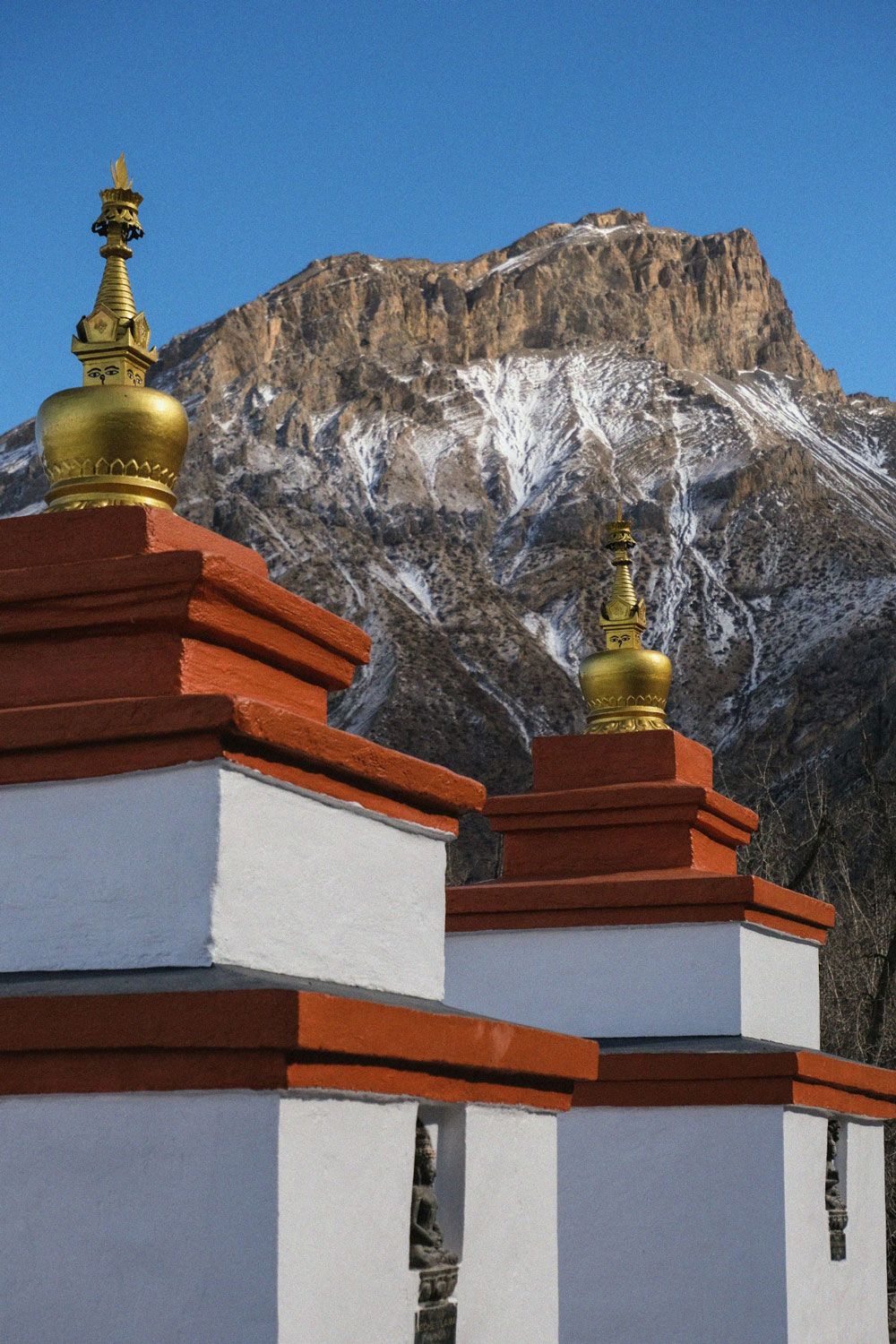
For Buddhists, Muktinath is equally venerated but in a different light. Buddhists refer to the site as Chumig Gyatsa, meaning “Hundred Waters,” highlighting the presence of the many holy water springs. It is one of 24 important Tantric sites in the Tibetan Buddhist world, associated with sky-dancing goddesses and powerful yogis. According to Buddhist legend, Guru Rinpoche (Padmasambhava) – the 8th-century sage who spread Buddhism in Tibet – meditated at Muktinath on his journey to Tibet and blessed the area.
To Buddhist pilgrims, the central deity of Muktinath Temple (a Vishnu statue) is worshipped as a form of Avalokiteshvara (Chenrezig), the Bodhisattva of Compassion. The temple’s eternal flame is revered in Buddhism as well, symbolizing an undying spiritual presence. Uniquely, the shrine is cared for by Buddhist nuns, underscoring the cross-faith harmony. In Buddhist practice, visiting Chumig Gyatsa is thought to bring merit, spiritual cleansing, and a deeper understanding of compassion. Thus, Muktinath’s importance lies in its role as a crossroads of faith – a place where Hindus and Buddhists alike find divine inspiration and where the act of pilgrimage fosters mutual respect between religions.
Muktinath Temple’s architecture serves as a window into the rich cultural heritage of Nepal. Built in the traditional pagoda-style architecture, this sacred temple stands as a testament to Nepali craftsmanship and deep religious devotion. The design of Muktinath Temple is not merely about aesthetics – every architectural choice carries profound cultural and spiritual significance, reflecting the temple’s role as a bridge between the earthly realm and the divine.
Elements of Design of the Temple
- Pagoda Style: The temple’s multi-tiered pagoda roofs symbolize ascending tiers of heaven. This classic design element underscores the temple’s role as a link between earth and the divine, illustrating how architecture can represent spiritual ascent. Each tier of the roof is an embodiment of reverence, guiding the eyes upward in a metaphorical journey toward the heavens.
- Golden Pinnacle: At the apex of the temple sits a gleaming golden pinnacle that shines brightly against the Himalayan sky. This pinnacle (gajur) is more than an ornamental crown; it represents purity and enlightenment. In Nepali spiritual tradition, a golden summit signifies the ultimate goal of eternal bliss or moksha (liberation). Its lustrous presence atop the temple serves as a constant reminder of the spiritual aspirations central to Muktinath’s devotees.
Cultural Touchpoints
- Prayer Flags: Surrounding the temple are vibrant prayer flags fluttering in the mountain breeze. These colorful prayer flags are emblematic of good fortune and spiritual well-being in Himalayan culture. Locals and pilgrims alike believe that as the wind rustles through the flags, prayers and mantras inscribed on them are carried across the region. This practice not only adds a burst of color to the serene landscape but also enhances the sanctity of the site – the very air around Muktinath Temple is thought to be infused with blessings and positive energy.
- Devotional Atmosphere: Visitors to Muktinath Temple are immediately immersed in a profoundly devotional atmosphere. The moment one enters the temple grounds, the air comes alive with the sound of sacred chants and prayers. This ambient chorus of devotion envelops visitors, creating an immersive spiritual experience. The soothing rhythms of prayer underscore the temple’s role as a holy sanctuary for reflection, worship, and inner peace. Even for those who come as observers, the palpable sense of reverence and tranquility highlights the cultural significance of Muktinath as a sacred space where the material and spiritual worlds converge.
In conclusion, the architectural elements of Muktinath Temple are not only visually stunning but also rich in cultural symbolism. From the tiered pagoda roofs to the smallest prayer flag, each aspect of the temple’s design has been thoughtfully chosen to reflect and uphold the spiritual values of the region. Muktinath Temple stands as an architectural marvel that encapsulates the spiritual ethos of Nepal, reminding all who visit that art, architecture, and faith are deeply intertwined in this revered Himalayan sanctuary.
Weather and Altitude of Muktinath Temple
In the summer months, days are generally mild, with average temperatures ranging from about 15°C to 20°C (59–68°F). However, because of the thin air and open valley, it can feel quite warm under the daytime sun and then quickly turn cool when clouds roll in or in the shade. Even summer evenings can be brisk, sometimes dropping into single digits (°C), so a jacket is needed. Strong afternoon winds are a hallmark of the Mustang region – by noon, gusts often whip through the valley. Jomsom is famously windy which can make the air feel colder and occasionally kick up dust.
In winter, Muktinath is very cold. Daytime highs might hover around 0°C (32°F) or only a few degrees above, and at night it plummets well below freezing. The area sees snowfall regularly in winter, sometimes accumulating significantly. The temple itself sits on a sunny slope, but surrounding areas can be snowbound for weeks. Travelers in winter must dress in heavy winter clothing and be prepared for icy paths. The cold is compounded by altitude – the air is dry and contains less oxygen, which can make physical activity more taxing.
Rainfall: Most of Muktinath’s precipitation comes during the monsoon (June–August), but as mentioned, Mustang lies in a rain shadow. This means that while lower regions get heavy rain, Muktinath sees far fewer rainy days. Instead, you might experience light showers or overcast skies in summer, and the terrain stays comparatively arid. Still, the approach roads before Jomsom which are outside the full rain shadow can receive rain and even landslides in monsoon, affecting travel indirectly.
Altitude effects: The high elevation is a defining factor in Muktinath’s weather and in visitors’ experience. The sun’s UV radiation is stronger at altitude – a clear day can give you a sunburn faster than you expect, so wearing sunscreen and sunglasses is important even if the air feels cool. The altitude also brings the risk of altitude sickness. Visitors coming from low elevations should be aware of symptoms like headache, nausea, or dizziness. It’s wise to acclimatize gradually; spending a night in Jomsom (2,720 m) or Kagbeni (~2,800 m) before going up to Muktinath can help your body adjust. Always stay hydrated and avoid heavy exertion right after arriving at high altitude. If you do experience serious altitude sickness symptoms, it’s crucial to descend to a lower altitude.
In summary, Muktinath’s weather is characterized by mild, breezy summers and extremely cold, snowy winters, with relatively low humidity year-round. No matter when you visit, pack layers – warm clothing for evenings (even in summer), a windproof jacket, and rain protection during monsoon months. By respecting the power of the mountain environment, you can safely enjoy the beauty of Muktinath in any season.
Best time to Visit Muktinath Temple
Choosing the right season is key to a successful trip, as Muktinath’s high-altitude climate can be extreme. Generally, the best times to visit are spring and autumn when weather conditions are most favorable. Here’s a breakdown by season:
- Spring (March to May): Spring is one of the most popular times to visit. The weather starts to warm up after winter, and daytime temperatures are pleasantly cool. Skies are often clear with stunning mountain views, and the surrounding hillsides come alive with wildflowers including Nepal’s famous rhododendrons in lower elevations. This season is ideal for trekking and pilgrimage alike, as trails are dry and the climate is comfortable. Do expect occasional spring showers, but they are usually short-lived.
- Summer (June to August): This period coincides with Nepal’s monsoon. In much of the country, heavy rainfall is common in summer, but Muktinath, being in the rain-shadow of the Annapurna range, receives less rain than the lower regions. The valley turns lush and green, and waterfalls along the route swell with rainwater. However, traveling in summer has drawbacks: roads can be muddy or landslide-prone, and flights to Jomsom are frequently delayed or canceled due to weather and cloud cover. Trekking is also more challenging with leeches and slippery trails at lower altitudes. If you visit in summer, be prepared for flexible travel plans. On the plus side, the crowds are thinner, and you might coincide with local festivals like Yartung which is a traditional horse-racing festival in Mustang around August, which offers a rich cultural experience.
- Autumn (September to November): Autumn is another peak season and arguably the best time to visit Muktinath. After the monsoon rains, the air is crisp and clean, offering crystal-clear views of the Himalayas. The weather is generally stable and dry, with mild days and cool nights – perfect for trekking and outdoor exploration. Many pilgrims and tourists schedule their trip in October or November when temperatures are moderate and the landscape is still green from the monsoon. This season also aligns with Nepal’s major holidays like Dashain and Tihar and a large influx of pilgrims during the annual Muktinath Yatra (pilgrimage journey) often takes place in early autumn. Accommodations can fill up quickly during this time, so plan ahead.
- Winter (December to February): Visiting in winter is for the hardy and well-prepared. Muktinath sees harsh winter conditions – temperatures frequently drop below freezing, and snowfall is common. The temple area and trails can be snow-covered from late December through February. Many teahouses and lodges in higher villages may close for the off-season, and trekking routes like the Thorong La pass are usually impassable due to heavy snow. That said, a winter visit is possible if you arrange private jeeps or helicopter transport during clear weather windows. You’ll experience a serene atmosphere with very few other tourists, and the temple in a blanket of snow is a magical sight. Just be ready for biting cold, and always check accessibility – sometimes heavy snowfall can temporarily block the road to Muktinath. Only undertake a winter trip if you are comfortable with extreme cold and have flexible timing.
Links : https://mustangnepal.com/the-perfect-time-to-visit-mustang-nepal-complete-guide-for-2022/
Must-Visit Places Near Muktinath Nepal: Kagbeni, Jomsom & Mustang Valley
The journey to Muktinath isn’t only about the temple – the surrounding Mustang Valley is rich with cultural and natural attractions that are well worth exploring. Here are a few nearby highlights to include in your itinerary:
Kagbeni
Located about 10 km downstream from Muktinath, Kagbeni is a picturesque medieval village set at the confluence of the Kali Gandaki and Jhong rivers. Many travelers pass through Kagbeni on the way to Muktinath or when trekking the Annapurna Circuit.
Stepping into Kagbeni is like stepping back in time: you’ll wander through narrow alleys of mud-brick houses, chortens (stupas), and a labyrinth of tunnels and courtyards. The village is an ancient Thakali settlement and also a checkpoint for entering the restricted Upper Mustang region. Don’t miss the Kagbeni Monastery (also called Kag Chode Thubten Samphel Ling) which dates back to the 15th century – its red-painted walls and prayer wheels reflect Tibetan Buddhist heritage.
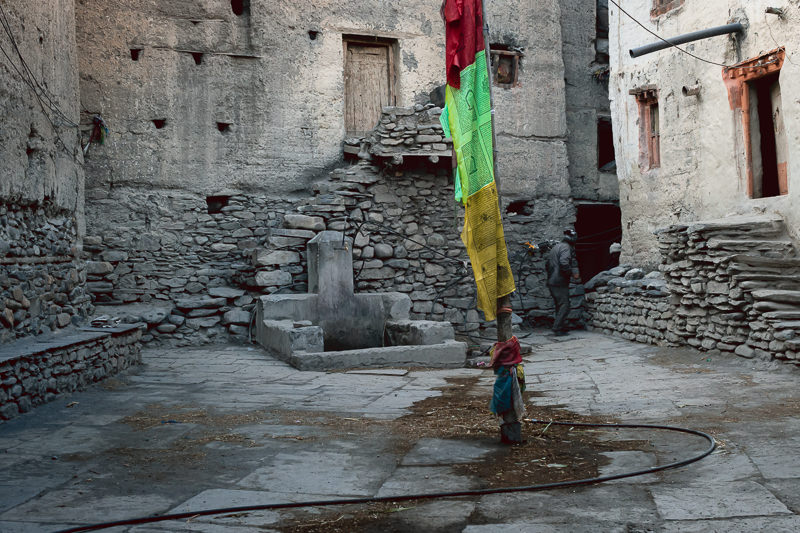
Kagbeni’s riverside location is notable for another reason: the Kali Gandaki here is famous for Shaligram fossils. You might spot locals (and pilgrims) searching the riverbed for these black ammonite stones believed to be sacred manifestations of Vishnu. With its oasis of green fields against stark brown cliffs and white mountain peaks, Kagbeni offers photographers and nature lovers an amazing contrast of landscapes. It’s an ideal place to stop for lunch or overnight; there are a few guesthouses where you can experience local hospitality like trying some Thakali cuisine if you stay – the lentil soup and buckwheat flatbread are local staples. Kagbeni’s charm, history, and scenery make it more than just a waypoint – it’s a highlight of Mustang in its own right.
Jomsom:
located approximately 20 km south of Muktinath, Jomsom is the administrative headquarters of Mustang District and the region’s transportation hub. If you’re coming by flight, this is where you land – the town has an airport famously known for its dramatic approach between towering mountains.
Pics: Upper mustang valley
Jomsom sits on the bank of the Kali Gandaki River at around 2,700 m altitude and offers splendid views of Nilgiri and Dhaulagiri peaks. While Jomsom itself is a modernizing town with an army camp, schools, a hospital, and a bustling market street, it’s a convenient base for travelers. Here you can find ATMs, a variety of lodges and hotels, and even a Mustang Eco-Museum that showcases local culture and fossils. Jomsom is known for its howling winds and for the delicious apples grown in the area. In fact, just a short walk or drive away is Marpha village, renowned for its apple orchards and distilled apple brandy – a tasting is a must for fruit lovers.
From Jomsom, many trekking routes diverge: west to Dolpo, north to Upper Mustang, and east across the Thorong La to Manang. But even if you’re not trekking further, spend some time in Jomsom to enjoy the valley views. You can take a stroll along the riverbed to see the timeless practice of locals crossing the Kali Gandaki on suspension bridges and perhaps witness mule caravans carrying goods. The sunrise and sunset in Jomsom are spectacular as the golden light hits the Nilgiri range. For pilgrims, Jomsom is where the journey to Muktinath often really begins – taking a jeep or hiking from here. The mix of traditional culture and necessary amenities makes Jomsom a comfortable and interesting stopover.
Mustang Valley:
The entire Mustang region is often called the “Forbidden Kingdom” because Upper Mustang was a restricted demilitarized zone until the 1990s, preserving a unique Tibetan-influenced culture. While visiting Muktinath, you are in Lower Mustang, but you get a taste of Mustang’s dramatic landscapes – eroded sandstone cliffs in hues of red and brown, caves carved into canyon walls, and sparse vegetation that give it a trans-Himalayan desert feel.
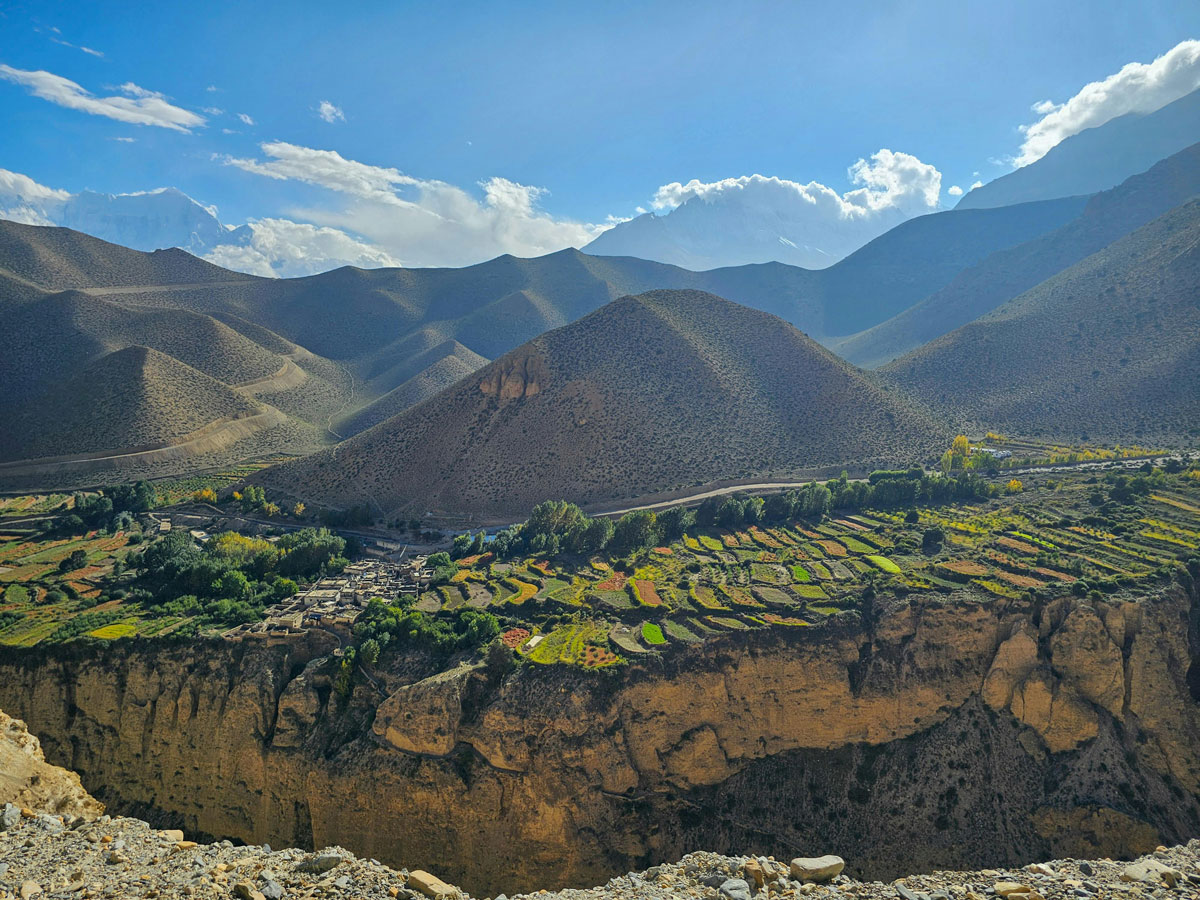
Many travelers extend their trip to venture into Upper Mustang beyond Kagbeni for which special permits are required to reach the fabled walled city of Lo Manthang, the former kingdom’s capital. Whether or not you go that far, the Mustang Valley around Muktinath offers plenty to see. You can visit Jharkot, a village just below Muktinath, which has an ancient fort and a beautiful old monastery overlooking the valley. The panoramic views from Jharkot of the Nilgiri and Tukuche peaks are stunning. Nature enthusiasts might take a side trip to Dhumba Lake near Jomsom, a small emerald-green lake tucked beneath mountain cliffs, or hike to Rupse Waterfall further down the road towards Tatopani.
The Mustang region is also famous for its dramatic sky caves – hundreds of man-made caves high in the cliffs that were used in ancient times as living quarters, monasteries, or tombs. While those near Chhusang or further north are a separate adventure, just knowing you’re in a landscape with so much history adds to the experience. Culturally, Mustang is predominantly Tibetan Buddhist. You’ll notice prayer flags fluttering on high points, long mani stone walls carved with Buddhist prayers, and perhaps encounter local people in traditional Tibetan dress, especially if you visit during festival times. One such event is the Tiji Festival in Lo Manthang, which is a spectacular three-day ritual.
Links : https://mustangnepal.com/sky-caves-the-mysterious-caves-of-nepal/, https://mustangnepal.com/festivals-of-mustang-nepal/
Tips for Travelling to Muktinath Nepal
Visiting Muktinath is a special experience. To make the most of it while staying safe and respectful, keep these practical tips in mind:
- Acclimatize and stay hydrated: Since Muktinath is at above 3,700 meters, give your body time to adjust to the altitude. If possible, spend a night or two at an intermediate elevation e.g. Pokhara which is at 800m, then Jomsom or Kagbeni around 2,800m before ascending to the temple. Stay well-hydrated and avoid heavy exertion or alcohol upon arrival. This helps prevent altitude sickness. If you feel symptoms like headache or dizziness, rest and descend if they worsen.
- Pack warm layers (even in summer): The weather in Muktinath can be unpredictable, it tends to get chilly year-round, especially in the evenings and early mornings. Bring a warm jacket, a woolen cap, gloves, and plenty of layers so you can adjust to temperature swings. Even in summer, nights are cold at high altitude. A windproof outer layer is useful, since Mustang is known for strong winds. In winter, heavy-duty winter gear is essential. Dressing in layers will keep you comfortable as you experience both sun and shade, calm and wind.
- Wear appropriate, modest attire: Muktinath is a holy site for Hindus and Buddhists. Out of respect, dress modestly when visiting the temple – long pants or skirts and shirts that cover your shoulders are recommended. This applies to both men and women. You’ll also need to remove your shoes when entering the inner temple area, so having footwear that’s easy to take on/off is handy. It’s a good idea to carry a pair of warm socks for walking around the cold stone temple courtyard barefoot.
- Plan for unpaved roads and dust: If traveling by jeep or bus, be prepared for very bumpy roads, especially on the Jomsom to Muktinath stretch. The ride can be rough, and dust is common in the dry season, so a face mask or buff and sunglasses can help protect against dust and wind. Motion sickness pills might be useful for those prone to carsickness on winding mountain roads.
- Allocate buffer time for travel: Transport in the Himalayas doesn’t always run like clockwork. Flights to Jomsom are weather-dependent and can be delayed or canceled due to wind or clouds. Landslides or road washouts can occur in the monsoon. It’s wise not to schedule tight connections. Give yourself an extra day or two in your itinerary as a buffer, especially if you have an international flight to catch after. This way, you won’t be stressed if you encounter a travel delay.
- Carry essentials (cash, medicine, power backup): Facilities in the Muktinath area are basic. ATMs are only available in Jomsom and Pokhara, so carry enough Nepali rupees for your expenses like meals, lodging, and donations before heading up. Pack a small first-aid kit including any personal medications, altitude sickness medicine (if prescribed), pain relievers, and band-aids. Also consider bringing a portable battery pack – electricity can be intermittent in the mountains, and you’ll want to keep cameras and phones charged for the beautiful photos.
- Lodging and food: Accommodation near Muktinath is mostly simple teahouses and guesthouses in Ranipauwa and Jharkot villages. They provide basic but comfortable rooms and traditional Nepali meals like rice and lentil soups. Don’t expect luxury at the top; hot water and heating may be limited. It’s a good idea to pack a sleeping bag in colder months for extra warmth at night. In Jomsom and Kagbeni, lodging options range from basic to a few nicer hotels – but overall, the region retains a rustic charm. Always have some snacks with you, as the journey can be long between meal stops.
- Respect local customs and spiritual atmosphere: Muktinath is first and foremost a sacred pilgrimage site. Keep a respectful demeanor within the temple complex – speak softly, and avoid public displays of affection. Always ask before photographing locals or monks/nuns, and avoid pointing your feet towards religious icons. It is considered as a common sign of disrespect in Nepal. If you wish to take a holy bath under the 108 spouts, remember the water is frigid – many pilgrims do it quickly and change into dry clothes immediately after, so have a towel and a change of clothes ready. Participate in or observe the rituals with an open mind – whether it’s lighting incense, ringing the prayer bells, or spinning Buddhist prayer wheels, feel free to join in respectfully.
- Permits and guides: If you’re trekking or going off the main road, ensure you have the necessary permits (ACAP and TIMS as noted) and carry them with you, as there are checkpoints. Hiring a local guide can greatly enrich your experience – they can share insights about the temple legends, ensure you don’t miss hidden shrines like the Jwala Mai temple, and help with translation if needed. Guides or porters are also helpful if you plan to hike, as they carry extra load and provide support on tricky sections. Solo travelers are advised not to wander off alone on less-traveled trails; stick to the main routes or have a guide/companion for safety in the remote terrain.
By keeping these tips in mind, you’ll be well-prepared for your Muktinath adventure. This journey offers not just the fulfillment of reaching a famed pilgrimage site, but also the joy of exploring Nepal’s captivating Mustang region.
FAQs about Muktinath Temple Nepal
Muktinath Temple is in Mustang district, Nepal, at an altitude of 3,800 meters near the Annapurna Circuit.
From Pokhara, you can either fly to Jomsom and drive/trek to Muktinath, or take a jeep all the way, which takes 2 days. From Kathmandu, you must drive to Pokhara first, then continue the journey.
The most popular route is via the Annapurna Circuit trek. It involves moderate to challenging trails depending on your starting point. You can also trek from Jomsom to Muktinath in 1–2 days—easier and scenic.
Visit between March–May and September–November. These seasons offer clear skies, stable weather, and good road and flight conditions.
You’ll find tea houses, guesthouses, and small hotels in Ranipauwa (near Muktinath) and Jomsom. Meals are mostly simple Nepali and Tibetan-style (dal bhat, noodles, soup, etc.).
Go slow to avoid altitude sickness. Stay hydrated, rest well, and avoid alcohol. Carry basic medicines and consult your doctor if you have respiratory or heart issues. Consider acclimatizing in Jomsom before visiting.
From Pokhara: ~170 km (via road or flight + jeep).
From Kathmandu: ~375 km by road (2-3 days).
You'll need the Annapurna Conservation Area Permit (ACAP) and TIMS card. No special permit if visiting by road or flight.
March to May and September to November offer the best weather for travel and views.
Yes, it’s a popular stop on the Annapurna Circuit trek, or you can hike from Jomsom (1–2 days).
It’s accessible by jeep or flight from Pokhara to Jomsom, then a short drive or hike.
Cool to cold year-round. Even in summer, nights are chilly. Winters (Dec–Feb) can bring snow.
Yes, Jomsom and Ranipauwa offer lodges, tea houses, and basic hotels.
Not mandatory, but helpful if trekking. For comfort, hire in Pokhara or Jomsom.
A 3 to 5-day trip from Pokhara is ideal, depending on route and stops.

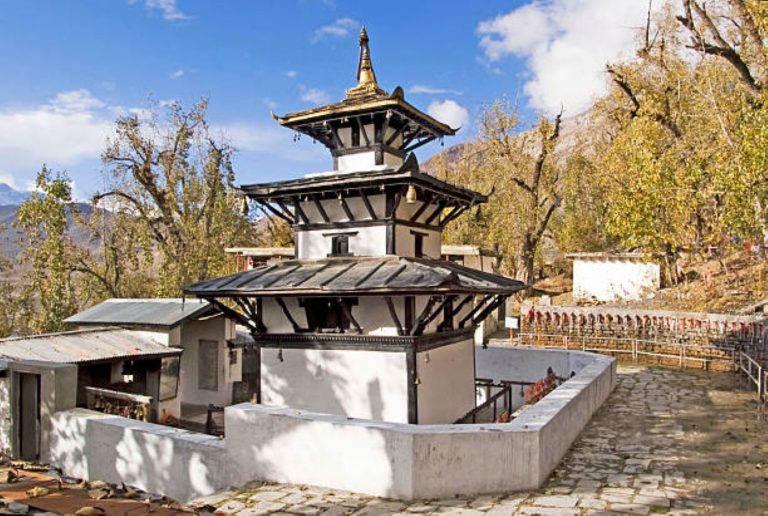
Comment (0)